ECU SKODA SUPERB 2007 1.G / (B5/3U) User Guide
[x] Cancel search | Manufacturer: SKODA, Model Year: 2007, Model line: SUPERB, Model: SKODA SUPERB 2007 1.G / (B5/3U)Pages: 259, PDF Size: 14.71 MB
Page 70 of 259
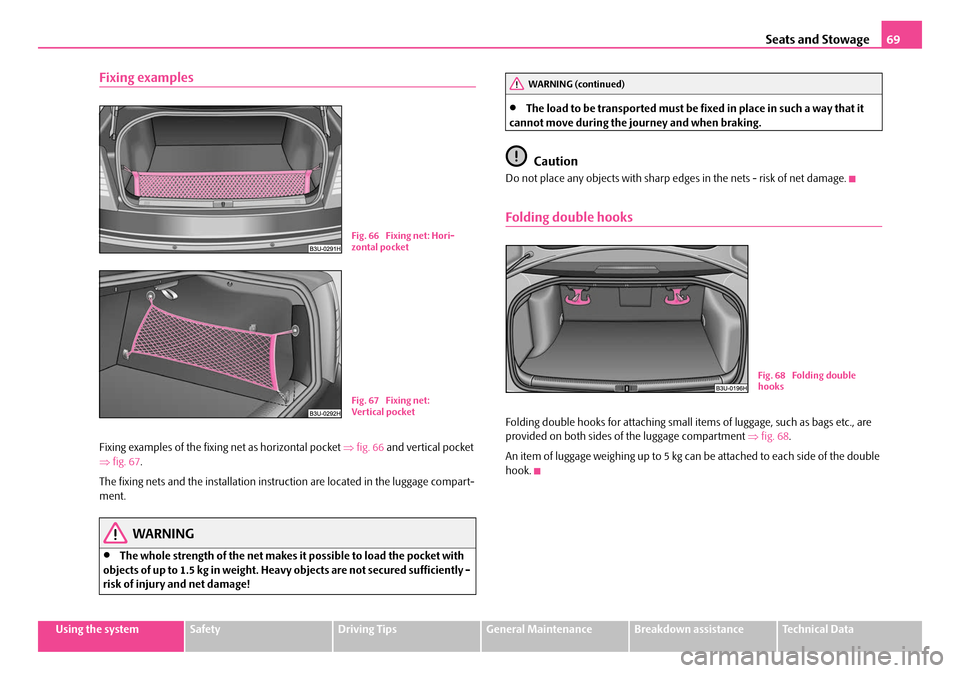
Seats and Stowage69
Using the systemSafetyDriving TipsGeneral MaintenanceBreakdown assistanceTechnical Data
Fixing examples
Fixing examples of the fixing net as horizontal pocket ⇒fig. 66 and vertical pocket
⇒ fig. 67 .
The fixing nets and the installation inst ruction are located in the luggage compart-
ment.
WARNING
•The whole strength of the net makes it possible to load the pocket with
objects of up to 1.5 kg in weight. Heavy objects are not secured sufficiently -
risk of injury and net damage!
•The load to be transported must be fixed in place in such a way that it
cannot move during the journey and when braking.
Caution
Do not place any objects with sharp edges in the nets - risk of net damage.
Folding double hooks
Folding double hooks for attaching small it ems of luggage, such as bags etc., are
provided on both sides of the luggage compartment ⇒fig. 68 .
An item of luggage weighing up to 5 kg can be attached to each side of the double
hook.
Fig. 66 Fixing net: Hori-
zontal pocket
Fig. 67 Fixing net:
Ver tical pocket
WARNING (continued)
B1Z-0042HB1Z-0042HFig. 68 Folding double
hooks
NKO B5 20.book Page 69 Friday, March 2, 2007 1:46 PM
Page 72 of 259
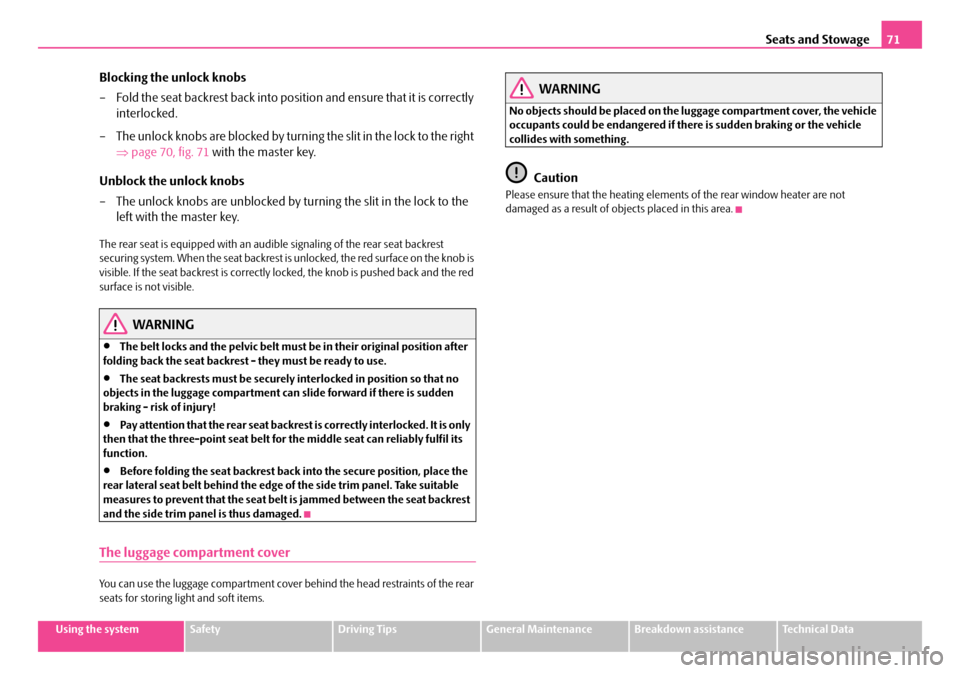
Seats and Stowage71
Using the systemSafetyDriving TipsGeneral MaintenanceBreakdown assistanceTechnical Data
Blocking the unlock knobs
– Fold the seat backrest back into position and ensure that it is correctly
interlocked.
– The unlock knobs are blocked by turning the slit in the lock to the right ⇒page 70, fig. 71 with the master key.
Unblock the unlock knobs
– The unlock knobs are unblocked by turning the slit in the lock to the left with the master key.
The rear seat is equipped with an audi ble signaling of the rear seat backrest
securing system. When the seat backrest is unlocked, the red surface on the knob is
visible. If the seat backrest is correctly locked, the knob is pushed back and the red
surface is not visible.
WARNING
•The belt locks and the pelvic belt must be in their original position after
folding back the seat backrest - they must be ready to use.
•The seat backrests must be securely interlocked in position so that no
objects in the luggage compartment can slide forward if there is sudden
braking - risk of injury!
•Pay attention that the rear seat backrest is correctly interlocked. It is only
then that the three-point seat belt for the middle seat can reliably fulfil its
function.
•Before folding the seat backrest back into the secure position, place the
rear lateral seat belt behind the edge of the side trim panel. Take suitable
measures to prevent that the seat belt is jammed between the seat backrest
and the side trim panel is thus damaged.
The luggage compartment cover
You can use the luggage compartment cover be hind the head restraints of the rear
seats for storing light and soft items.
WARNING
No objects should be placed on the luggage compartment cover, the vehicle
occupants could be endangered if there is sudden braking or the vehicle
collides with something.
Caution
Please ensure that the heating elements of the rear window heater are not
damaged as a result of obje cts placed in this area.
NKO B5 20.book Page 71 Friday, March 2, 2007 1:46 PM
Page 73 of 259

Seats and Stowage
72
Through-loading bag*
The through-loading bag enables you to conveniently transport long
objects (such as skis) without damaging the interior of the car.
Loading
– Fold down the armrest of the rear seats to the front.
– Press the unlock button for the cover of the through-loading bag in the
interior of the car and swivel it down.
– Pull the bag out and unfold it.
– Open the boot lid/luggage compartment door. – Press the unlock button for the cover of the through-loading bag
⇒fig. 72 and swivel it down.
– Push the objects into the through-loading bag from the boot ⇒.
Securing
– Insert the belt ⇒fig. 73 into the middle seat belt buckle .
– Pull the seat belt tight in direction of arrow ⇒fig. 73 .
Stowing
– Close the cover for the through-loading bag in the boot.
– Carefully fold the through-loading bag together in segments of approx 11 cm in length.
– Close the cover in the interior of the car.
– Move the armrest back into its original position.
WARNING
•After placing items into the through- loading bag, you must secure the
bag with the securing belt .
•The securing belt must hold the items tight.
•Ensure that the securing belt on ski sport articles lies in the middle
between the bindings (see imprin t on the through-loading bag).
Note
•Place the skis with the tips facing the fr ont, snowboards and ski sticks with the
tips facing the rear into the through-loading bag.
•If there are several pairs of skis in the through-loading bag, ensure that the bind-
ings are positioned at the same height.
•The through-loading bag must never be folded together or stowed when
moist.
Fig. 72 Luggage
compartment: cover for
through-loading bag
B1Z-0042HB1Z-0042H
Fig. 73 Attaching
through-loading bag to
middle seat belt buckle
of rear seats
AAAB
AC
AA
NKO B5 20.book Page 72 Friday, March 2, 2007 1:46 PM
Page 76 of 259

Seats and Stowage75
Using the systemSafetyDriving TipsGeneral MaintenanceBreakdown assistanceTechnical Data
CargoFlex folding box*
Lowering and securing folding box
You can transport the folding box in two different positions - in the trans-
port position against the partition ⇒fig. 78 of the luggage compartment,
or in the ready position lowered onto the floor of the luggage compart-
ment ⇒fig. 79 .
Lowering folding box into the ready position
– Pull the snap handle in direction of arrow 1 ⇒ fig. 78 . The folding box
is lowered to just above the floor of the luggage compartment. – Press the folding box at the arrow positions
2 ⇒ fig. 79 onto the floor
of the luggage compartment until it locks in place. If correctly locked,
the snap handle moves back into its initial position (the top red
surface of the handle is not visible).
Securing folding box in the transport position against partition of
luggage compartment
– Lower the folding box into the ready position ⇒page 77.
– Pull the snap handle in direction of arrow 1 ⇒ fig. 78 . The folding box
is raised up from the luggage compartment floor.
– Raise and press the folding box against the partition of the luggage compartment, it is secured audibly in this way in the transport posi-
tion. If correctly locked, the snap handle moves back into its initial
position (the top red surface of the handle is not visible).
Opening folding box ⇒page 76.
Caution
•The parts of the folding box can be dama ged if handled roughly or in an unpro-
fessional way.
•Before you lower the folding box B into the ready position ⇒fig. 79 , it is neces-
sary to remove the net*, in order to avoid net damage.
B1Z-0042HB1Z-0042HFig. 78 Folding box:
Transport position
Fig. 79 Folding box:
ready position
NKO B5 20.book Page 75 Friday, March 2, 2007 1:46 PM
Page 77 of 259

Seats and Stowage
76
Opening folding box
You can transport the opened folding box in the secured end or middle
position against the partition of the luggage compartment.
Opening folding box
– Lower the folding box into the ready position ⇒page 75.
– Press the button marked “PUSH” ⇒fig. 80 . – Grasp the folding box at the handle and push it in direction of
arrow 1 against the partition of the luggage compartment into the
secured position. The lock below the button must be heard to engage.
If correctly locked, the button mark ed “PUSH” moves back into its
initial position.
– Raise the lid in direction of arrow 2 ⇒ fig. 81 .
– Press on the bottom part of the handle and open the compart- ments in the direction of arrow 3. The compartment wall must be
heard to engage in the slot in the bottom part of the box.
Moving folding box into secured middle position
– Press on the button marked “PUSH” ⇒fig. 81 and carefully push
the folding box into the secured mi ddle position. If correctly locked,
the button marked “PUSH” is moved back into its initial position.
You can now use the space which ha s become available for stowing
further items of luggage.
Caution
•The parts of the folding box can be dama ged if handled roughly or in an unpro-
fessional way.
•The maximum weight of goods to be loaded should not exceed 25 kg.
B1Z-0042HB1Z-0042H
Fig. 80 Luggage
compartment: folding
box
B1Z-0042HB1Z-0042HFig. 81 Opening folding
box
AB
AA
AB
AC
AD
AD
NKO B5 20.book Page 76 Friday, March 2, 2007 1:46 PM
Page 78 of 259
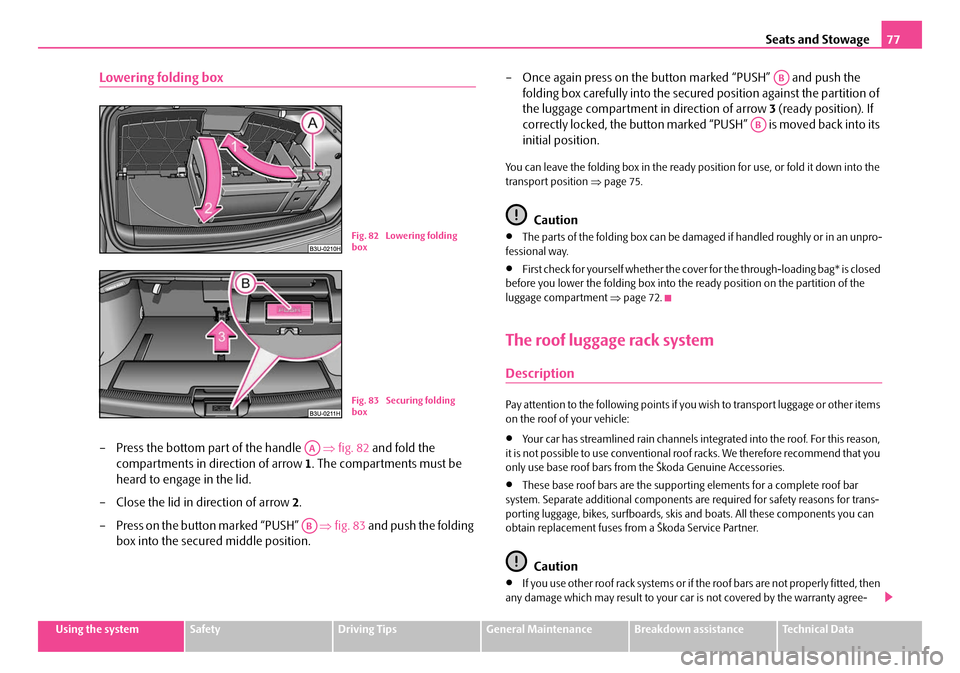
Seats and Stowage77
Using the systemSafetyDriving TipsGeneral MaintenanceBreakdown assistanceTechnical Data
Lowering folding box
– Press the bottom part of the handle ⇒fig. 82 and fold the
compartments in direction of arrow 1. The compartments must be
heard to engage in the lid.
– Close the lid in direction of arrow 2.
– Press on the button marked “PUSH” ⇒fig. 83 and push the folding
box into the secured middle position. – Once again press on the button marked “PUSH” and push the
folding box carefully into the secured position against the partition of
the luggage compartment in direction of arrow 3 (ready position). If
correctly locked, the button marked “PUSH” is moved back into its
initial position.
You can leave the folding box in the ready position for use, or fold it down into the
transport position ⇒page 75.
Caution
•The parts of the folding box can be dama ged if handled roughly or in an unpro-
fessional way.
•First check for yourself whether the cover for the through-loading bag* is closed
before you lower the folding box into the ready position on the partition of the
luggage compartment ⇒page 72.
The roof luggage rack system
Description
Pay attention to the following points if yo u wish to transport luggage or other items
on the roof of your vehicle:
•Your car has streamlined rain channels in tegrated into the roof. For this reason,
it is not possible to use conventional r oof racks. We therefore recommend that you
only use base roof bars from the Škoda Genuine Accessories.
•These base roof bars are the supporti ng elements for a complete roof bar
system. Separate additional components are required for safety reasons for trans-
porting luggage, bikes, surfboards, skis and boats. All these components you can
obtain replacement fuses from a Škoda Service Partner.
Caution
•If you use other roof rack sy stems or if the roof bars are not properly fitted, then
any damage which may result to your ca r is not covered by the warranty agree-
B1Z-0042HB1Z-0042HFig. 82 Lowering folding
box
B1Z-0042HB1Z-0042HFig. 83 Securing folding
box
AA
AB
AB
AB
NKO B5 20.book Page 77 Friday, March 2, 2007 1:46 PM
Page 147 of 259

Transporting children safely
146
Transporting children safely
What you should know about transporting children!
An introduction to the subject
Accident statistics have revealed that children are generally more
safely transported on the rear seat s than on the front passenger seat.
Children younger than 12 years of age should normally travel on the rear seat of the
vehicle (take note of any national legal pr ovisions which differ from this). They
should be secured there by means of a child restraint system or by using the existing
seat belts depending on their age, body si ze and weight. The child seat should be
mounted behind the front passen ger seat for safety reasons.
The physical principle of an accident does, of course, also apply to children
⇒ page 131, “The physical principle of a frontal collision”. They differ from adults in
that their muscles and bone structure of ch ildren are not yet fully developed. Thus
children are exposed to increased risk of injury.
Children should be transported by using special child safety seats in order to
reduce this risk of injury.
Use only child safety seats which are offici ally approved and are suitable for chil-
dren and which comply with the ECE-R 44 Standard, which classifies child safety
seats into 5 groups ⇒page 149, “Classification of child seats into groups”. Child
restraint systems which have been tested for conformity with ECE-R 44 have a non-
detachable test seal (a large E within a circle and below this the test number)
attached to the seat.
We recommend that you use child safety seats from the Škoda genuine accessories.
These child seats were developed and also tested for use in Škoda vehicles. They
fulfil the standard ECE-R 44.
WARNING
Always comply with national legal provisions and instructions from the rele-
vant child safety seat manufacturer when installing and using a child seat
⇒ in “Important safety information regarding the use of child safety
seats”.
Note
Any national legal provisions which vary from the information contained in this
Owner's Manual take precedence over the information contained herein.
Important safety information regarding the use of child safety
seats
Correct use of child safety seats considerably reduces the risk of
injury!
WARNING
•All the occupants of the car - in particul ar children - must wear a seat belt
when the car is moving!
•Children less than 1.50 m in height or younger than 12 years must not use
a normal seat belt without a child restraint system otherwise this may result
in injuries to the stomach and neck areas. Comply with the national legal
requirements.
•One should never carry children, an d also not babies! - on one's lap.
•You can transport a child safely in a suitable child safety seat ⇒page 149,
“Child seat”!
•Only one child may be fastened with a seat belt into a child safety seat.
•Never leave the child sitting unattended in the seat.
NKO B5 20.book Page 146 Friday, March 2, 2007 1:46 PM
Page 170 of 259
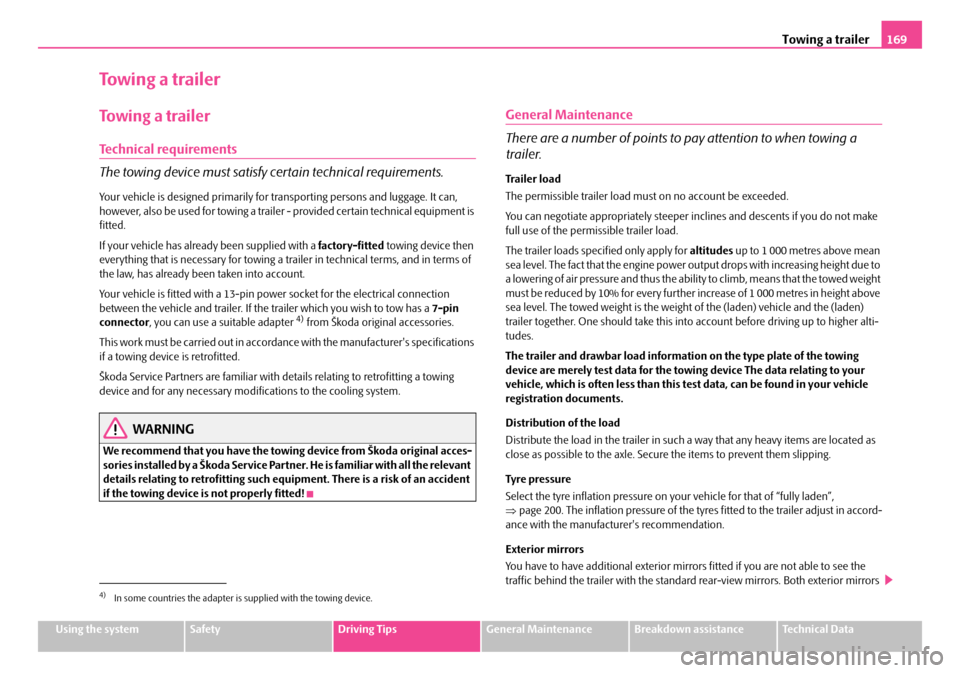
Towing a trailer169
Using the systemSafetyDriving TipsGeneral MaintenanceBreakdown assistanceTechnical Data
Towing a trailer
Towing a trailer
Technical requirements
The towing device must satisfy certain technical requirements.
Your vehicle is designed primarily for tran sporting persons and luggage. It can,
however, also be used for towing a trailer - provided certain technical equipment is
fitted.
If your vehicle has alre ady been supplied with a factory-fitted towing device then
everything that is necessary for towing a tr ailer in technical terms, and in terms of
the law, has already been taken into account.
Your vehicle is fitted with a 13-pin powe r socket for the electrical connection
between the vehicle and trailer. If the trailer which you wish to tow has a 7-pin
connector , you can use a suitable adapter
4) from Škoda original accessories.
This work must be carried out in accordan ce with the manufacturer's specifications
if a towing device is retrofitted.
Škoda Service Partners are familiar with details relating to retrofitting a towing
device and for any necessary modi fications to the cooling system.
WARNING
We recommend that you have the towing device from Škoda original acces-
sories installed by a Škoda Service Partner. H e is fa m il ia r wit h al l the re le v a nt
details relating to retrofitting such equipment. There is a risk of an accident
if the towing device is not properly fitted!
General Maintenance
There are a number of points to pay attention to when towing a
trailer.
Trailer load
The permissible trailer load must on no account be exceeded.
You can negotiate appropriately steeper incl ines and descents if you do not make
full use of the permissible trailer load.
The trailer loads specified only apply for altitudes up to 1 000 metres above mean
sea level. The fact that the engine power ou tput drops with increasing height due to
a lowering of air pressure and thus the abil ity to climb, means that the towed weight
must be reduced by 10% for every further increase of 1 000 metres in height above
sea level. The towed weight is the weight of the (laden) vehicle and the (laden)
trailer together. One should take this into account before driving up to higher alti-
tudes.
The trailer and drawbar load information on the type plate of the towing
device are merely test data for the towi ng device The data relating to your
vehicle, which is often less than this test data, can be found in your vehicle
registration documents.
Distribution of the load
Distribute the load in the trailer in such a way that any heavy items are located as
close as possible to the axle. Secure the items to prevent them slipping.
Tyre pressure
Select the tyre inflation pressure on yo ur vehicle for that of “fully laden”,
⇒ page 200. The inflation pressure of the tyres fitted to the trailer adjust in accord-
ance with the manufacturer's recommendation.
Exterior mirrors
You have to have additional exterior mirr ors fitted if you are not able to see the
traffic behind the trailer with the standard rear-view mirrors. Both exterior mirrors
4)In some countries the adapter is supplied with the towing device.
NKO B5 20.book Page 169 Friday, March 2, 2007 1:46 PM
Page 183 of 259

Fuel
182
Operation in winter
Winter-grade diesel fuel
A different grade of diesel fuel is available at filling stations in winter than during the
summer. Using “summer-grade diesel fuel” at temperatures below 0°C can result in
operational problems because the diesel be comes viscous as a result of paraffin
separation.
It is therefore the case that DIN EN 590 prescribes diesel fuel class for certain
periods of the year which can also be pu rchased at the corresponding time during
the year. “Winter-grade diesel fuel” will still operate properly even at a temperature
of -20°C.
It is often the case in countries with diff erent climatic conditions that diesel fuels
available have a different temperature characteristic. Škoda Service Partners and
filling stations in the country concerned wi ll be able to provide you with informa-
tion regarding the diesel fuels available.
Prewarming fuel
The vehicle is fitted with a fuel filter prewarming system. This secures operation of
a vehicle using diesel fuel down to an environmental temperature of -25°C.
Caution
It is not permitted to add the various fuel additives on the market, including petrol,
to diesel fuel in order to improve its flow properties.
Refuelling
Refuelling procedure
Opening the fuel filler cap
– Unlock the fuel filler flap with the switch in the driver door ⇒page 35.
– Open the fuel filler flap fully.
– Unscrew the cap by turning it to the left.
– Place the cap onto the top of the fuel filler flap ⇒fig. 170 .
Closing fuel filler cap
– Screw on the cap by turning it to the right until it is heard to lock.
– Press the fuel tank flap closed.
The correct grade of fuel for your vehicle as well as the tyre size and inflation pres-
sures are stated on a sticker affixed to the inside of the fuel filler flap. Further infor-
mation on fuel ⇒page 181, “Fuel”.
The fuel tank has a capaci ty of about 62 litres.
B1Z-0042HB1Z-0042HFig. 170 Filler flap with
cap unscrewed
NKO B5 20.book Page 182 Friday, March 2, 2007 1:46 PM
Page 186 of 259
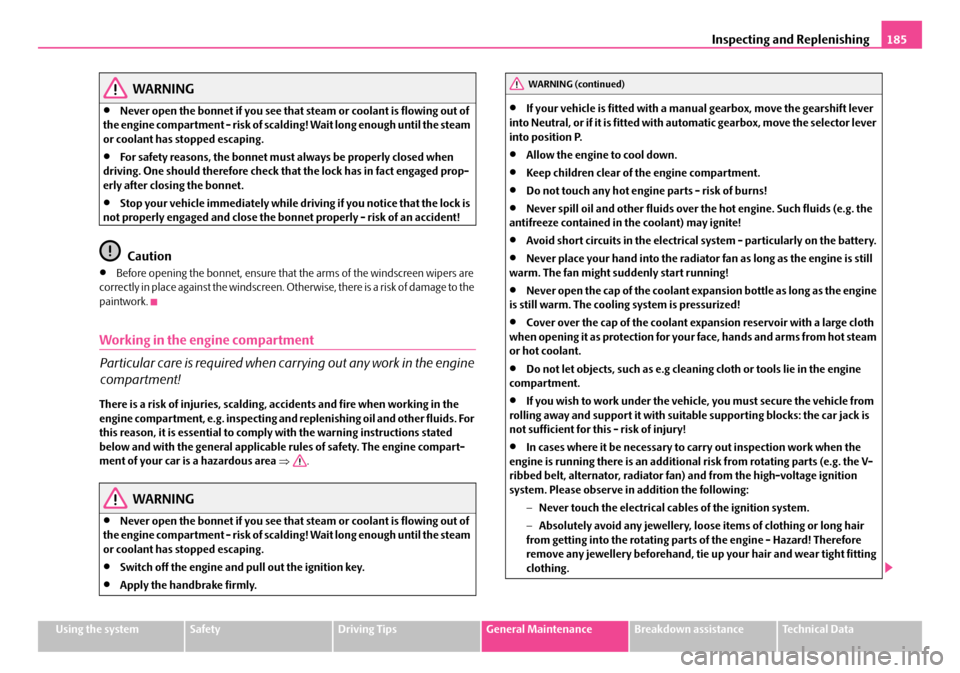
Inspecting and Replenishing185
Using the systemSafetyDriving TipsGeneral MaintenanceBreakdown assistanceTechnical Data
WARNING
•Never open the bonnet if you see that steam or coolant is flowing out of
the engine compartment - risk of scaldi ng! Wait long enough until the steam
or coolant has stopped escaping.
•For safety reasons, the bonnet must always be properly closed when
driving. One should therefore check that the lock has in fact engaged prop-
erly after closing the bonnet.
•Stop your vehicle immediately while driv ing if you notice that the lock is
not properly engaged and close the bonne t properly - risk of an accident!
Caution
•Before opening the bonnet, ensure that the arms of the windscreen wipers are
correctly in place against the windscreen. Otherwise, there is a risk of damage to the
paintwork.
Working in the engine compartment
Particular care is required when carrying out any work in the engine
compartment!
There is a risk of injuries, scalding, accidents and fire when working in the
engine compartment, e.g. inspecting and replenishing oil and other fluids. For
this reason, it is essential to comply with the warning instructions stated
below and with the general applicable rules of safety. The engine compart-
ment of your car is a hazardous area ⇒ .
WARNING
•Never open the bonnet if you see that steam or coolant is flowing out of
the engine compartment - risk of scaldi ng! Wait long enough until the steam
or coolant has stopped escaping.
•Switch off the engine and pull out the ignition key.
•Apply the handbrake firmly.
•If your vehicle is fitted with a ma nual gearbox, move the gearshift lever
into Neutral, or if it is fitted with automatic gearbox, move the selector lever
into position P.
•Allow the engine to cool down.
•Keep children clear of the engine compartment.
•Do not touch any hot engine parts - risk of burns!
•Never spill oil and other fluids over the hot engine. Such fluids (e.g. the
antifreeze contained in the coolant) may ignite!
•Avoid short circuits in the electrical system - particularly on the battery.
•Never place your hand into the radiator fan as long as the engine is still
warm. The fan might suddenly start running!
•Never open the cap of the coolant expa nsion bottle as long as the engine
is still warm. The cooling system is pressurized!
•Cover over the cap of the coolant expansion reservoir with a large cloth
when opening it as protection for your face, hands and arms from hot steam
or hot coolant.
•Do not let objects, such as e.g cleaning cloth or tools lie in the engine
compartment.
•If you wish to work under the vehicle, you must secure the vehicle from
rolling away and support it with suitable supporting blocks: the car jack is
not sufficient for this - risk of injury!
•In cases where it be necessary to carry out inspection work when the
engine is running there is an additional risk from rotating parts (e.g. the V-
ribbed belt, alternator, radiator fan) and from the high-voltage ignition
system. Please observe in addition the following:
−Never touch the electrical cabl es of the ignition system.
− Absolutely avoid any jewellery, loose items of clothing or long hair
from getting into the rotating parts of the engine - Hazard! Therefore
remove any jewellery beforehand, tie up your hair and wear tight fitting
clothing.
WARNING (continued)
NKO B5 20.book Page 185 Friday, March 2, 2007 1:46 PM